Friday 8th September 2017. Flight 17, West Jet. Dublin airport to St. John’s, NL.
I am at the gate, on my way to St. John’s in Canada. Outside the morning brightness reflects on large cumulus clouds: soft cream and blues. It may have taken a few years of talking about Newfoundland, but I am now lucky enough to have a two-week residency on this island.
Since pre Irish Famine times, people have been emigrating to Newfoundland from Ireland. They were going for the fishing but often came from farming backgrounds. Of all the emigrants, the Irish were the largest consortium to move their lives to Newfoundland and many families came from counties Waterford, Wexford, West Meath and Carlow, a place that I call home.
I am particularly curious to discover if the historical link with Newfoundland still exists though farming practices, methods or specific plants and if these are integrated into modern day food production.
I know it won’t be like stepping back into history yet I am looking for connections, traditions or knowledge that may have been passed down through families, I think about the emigrants in boats, bringing with them what they could carry, making this same journey, going to start a new life on a different island.

My initial reaction on arrival is that it really is a bit like ‘the other Ireland’. People (many), look, behave and speak like rural Irish folk and yet they also have that something else. Sure, the surroundings are different, yet I meet people like Joe Butler, the taxi driver, who could have come over on the plane with me from Carlow. It’s an odd city, because it feels like a town. They celebrate St. Patrick’s Day for a week here: I think they are more Irish than the Irish themselves.
The older heritage part of the town is full of multi coloured, wooden siding houses which run up and down the steep hills on which this place is built. Beyond these pretty homes lies the more modern element of St. John’s. It is functional, it is bulky and it is in stark contrast to the remaining historical buildings. Hugging the inlet harbour are very large cargo ships that, in colour, echo the heritage houses. The ships at the dock do not let you forget that this is a working town.
Once upon a time it was fishing that was the wealth of Newfoundland and Labrador (NL/LB), then it was gas, oil and minerals, now, I am told, that although the minerals are still being harvested, NL/LB is the poorest province in Canada.
Walking through the soft rain, I read the election posters (most of the names are of Irish decent). They appear, like surprises, to have sprung up on the green spaces along the road and the colours of the houses peer out through the day’s grey hue.
In the interest of research, I head off to the weekly Farmer’s Market that is held in and on the grounds of the Lion’s Sports Club. The market patch of grass is slippy with mud and still the rain comes down. Here are people selling their wares with smiles on their faces, welcoming greetings given to return customers and curious questions to new ones. Inside the clubhouse the framed photos of club presidents, past and present, wallpaper one wall. The vendors inside sell a mix of food, arts/craft and cosmetics, mingled with the smell of Indian spices and wet clothing.
The following day I am again met by rain, which has persisted all night. It’s fine, I didn’t come for the weather, but it does mean that I spend much of the day being wet.
I meet up with Lori Mac Carthy, nee Butler, at her house off Waterford Bridge Road. Lori lives in a part of town that is full of trees and nice gardens. Built on original farmland I see an apple tree in someone’s very green front lawn (they are big on lawns and flowers here), the apple tree is a survivor of the farming days when people grew food.
Through research I found out about Lori and it seems like a good place to start my inquiry. I am curious as to what food can still be harvested for free. Lori is a forager and a passionate educator and for her, mealtimes are a social engagement with family and others and no food is wasted..
Lori’s background is as a chef and she has now developed her love of food, foraging and education into a company called ‘Cod Sounds’ (https://www.codsounds.ca). She takes groups out to find free food on the land and offers classes on turning these finds into meals.
Having no use for a double garage at her house, Lori has re-developed this space into her workshop. This is where she experiments, where she butchers her fresh meat, be that elk or moose or once a year a pig; raised by a woman who does two pigs a year. This is where the ‘food gatherings’ take place and this is also where Lori passes on her expertise. As she delves deeper and deeper into the ideas, traditions and knowledge of foraging and living off the land, people are starting to sit up and listen.
The workshop space is warm from the wood-burning stove. Dark coloured timber logs lie to one side and an axe is comfortably embedded into one of these blocks. Various cooking pots are slowly bubbling on the stove, wafting out unusual meaty smells, I do not know exactly what is cooking.
Here you find an appreciation of the time it takes to make a meal. Bones from the animal carcass are cooked for hours and might be the evening meal she feeds her family, nothing is wasted.
Around her kitchen/work area, there are pots and pans, dishes and plastic containers full of herbs that have been picked in the wild. The half leg of some animal that has been smoked, hangs off the metal rack that contains salamis and other hunks of meat. There are elements of straight nature too. The round stones placed beside the wood-burning stove catch the heat and extend their warmth into the space. On a table sits a large antler and in front of it shells of a crustaceans that, now empty, have small tea lights in them. This workshop is where you can allow your mind to wander and also focus as we talk about food sustainability, food waste, and the hard fact that 90% of the food consumed in Newfoundland/Labrador has to be imported.
If you ship in 90% of your foodstuffs, prices and food packaging becomes a problem with enormous implications. Lori sits on the boards of many of the organisations such as ‘Food First’ who are trying to address the problems of food need, food waste and food education, but progress is slow and Lori feel that ‘maybe people really are not interested’.
She believes that it is only through teaching the young people that things will change. The skills and knowledge of how to make use of and mind the land and its produce is disappearing as the aging population of this province passes away and more and more people move off the land. The younger people, who have not grown up with food urgency, are not engaged enough with the issue, but it is changing, if slowly.
When the settlers came to set up house here, they brought with them plants that were not indigenous. The apples, pears, plumbs, damsons are all remnants of a settlers original homestead. They also brought blackberries and other soft fruits perhaps not knowing that there are of five varieties of blueberries to this area alone. When farms failed or through government interventions, people had to leave the land to more populated areas because of amenity costs, the fruit trees and bushes, of course remained. These now offer fruits each year but there is no one to gather or make us of their offerings.
Lori questions if young folk were encouraged to be keepers on the farms that were begun so many years ago, or, encouraged to pick the fruit that goes to waste or maybe, just maybe, through education and exposure, were given a chance to take up this food mantle, maybe, she hopes, food production, preservation and processing might become be part of the school curriculum. Perhaps then there would be the understanding that there is food here in this province, it does not all have to come in on the ships that crowd the dock, 24/7.
These are the things that Lori and I speak about and I also explaining about what I have experienced in Ireland. There too many farmers do not have that patch of home grown vegetables anymore and although there is not the same urgency as there is here, there is a large percentage of food wastage and a lack of understanding among those not connected to the land of the growing process and knowledge of what it takes to bring food to a plate.
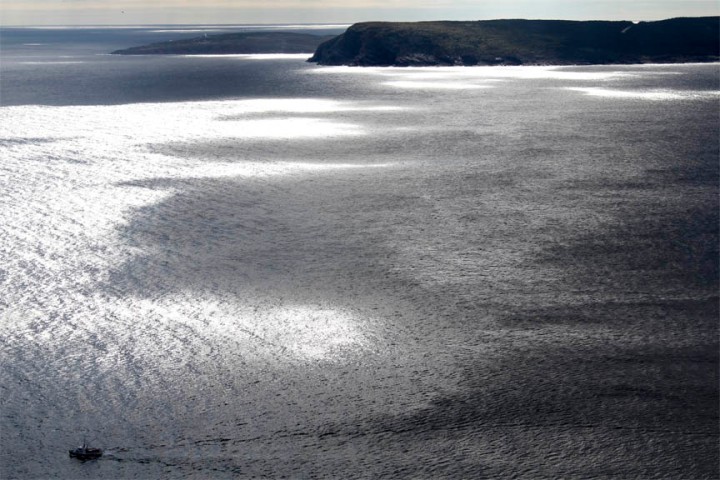
It’s still raining when its time to put on my boots and head over to Lester’s family farm.
Lester’s farm was started by John and Mary and has been a growing concern for three generations. As well as being a local vegetable shop, there are also children’s activities and a petting farm (which is probably the only place you are going to meet a cow or a sheep, as all the animals here seem to be kept indoors all year round).
The food on sale is enormous in size, no fine dining product here. The Kohlrabi is the size of a football, leeks as thick as my upper arm and shelf upon shelf of pickles and chutney. The magnitude and volume of it all kind of puts me off. This feels about bulk, not quality. They do not sell organic but on the weekends the car parks are full to overflowing with locals buying ‘local’ produce. Lori tells me that she thinks it is because of the feel good factor though most of the time she sees people leaving with flowers and loaves of white bread baked on the premises. She wishes that there could be a way to reverse this, encourage the public to go for taste not bulk, yet she select shops here herself and is encouraged by the idea of Lester’s farm but not the way in which it has become a supersized supermarket trying to be something else.
My final drenching of the day comes when I walk back to the Dominion supermarket. At the house I am staying we need to eat too and although there are only a few things to get, it takes me about an hour to get around the store. There is just so much to look at and investigate. I quietly try to take some photos because I don’t want people to think that I am being a tourist laughing at their wares, yet, I cannot resist documenting what I see. There are large, 4 foot x 4 foot wire baskets piled high with energy bars on sale. There are so many it speaks to me of the lack of worth, the carelessness in which this product, so rich in protein (and sugar) is so unceremoniously dumped in a wire cage.

I had also been told about a supermarket chain called Sobey, so I head out to find one of those. This supermarket is as large as the Dominion but it is different. The prices are roughly on par (food is expensive here, the importation, the shipping and the packaging must all be paid for) but the product on offer is aimed at a different clientele. As you walk in the door, a large poster confronts you to let you know that there is support for small Newfoundland producers here and the products are everywhere, it is great to see.
Thinking about food prices, food wastage and food packaging I head up to ‘The Gathering’, which is an outreach centre off the far end of Military Road. This place was started by the sisters of Mercy and the sisters of the Presentation in 1994.
At first the sisters used to leave sandwiches outside the centre’s door, but, it can rain a great deal here and they decided that if they were going to feed hungry people, soggy sandwiches were not the answer and so, The Gathering Place’ was created. There were many hungry people then and there are many hungry now.
An average of 200/250 hot lunches are served to the Guests each day. These lunches can be made because of donations in the form of financial gifts and produce are donated. Christmas being an especially good time for donations, it helps those who give, feel good.
Brendan O’Rourke is a young man of about 25 who is the ‘Gathering Place’s chef. He comes from Irish stock but considers himself to be a Newfoundlander. He has always loved to cook and now his job is to make a daily meal for those who need it the most. Many of the Guests who come here are either unemployed, suffer from mental issues or have had, or still, have substance abuse in their lives or, through various reasons, life has dealt them a hard road. The centre does not only serve food, it also provides medical assistance, a hairdresser, a chiropodist, advise on how to access government assistance and often just a listening ear.

Brendan is keen to serve food that is sourced locally but the prices are often higher than what can be imported. He mentions that local cod is twice the price of frozen blue cod from Alaska. There are some stores that gift excess produce such as Costco and there is a duality of thought about these gifts. Costco is a very large wholesaler of both fresh and long shelf life food. People shop there in large quantities because the produce is cheaper but this of course, in turn, creates food wastage on fresh produce. Brendan tells me examples of his parents who buy boxes of fruit and veg and inevitably much of it cannot be consumed before it turns. He tries to bring stuff in to the centre but his parents prefer to have large amounts of food in their house ‘just in case’. Brendan believes that this notion comes from the time when there was no easy access to food and when the saying ‘the hungry month of March’ meant exactly that. He considers it a learned anxiety; he sees this same worry among his guests.
The meals that the centre provides are mostly traditional Newfoundland recipes and food that the guests are used to. There could be stews or pastry based pies, doughboys, Jiggs dinner or moose, or, often the regular meat and a carbohydrate, vegetables not being very popular. He tries, when he can, to throw in some lentils or other healthy ingredients but he feels that having a meal that reminds the Guests of home or better times is more important than pushing a meal that is regarded as healthy and well balanced.
Standing in the community garden that the centre has started, Brendan explains with a passion his desire to help with the food shortage and dependence on imports. He would like to encourage hydroponic food production. It seems like such a good idea. The old fish houses are here and empty and the need is obvious. There was a company that did try this some years ago called Sprung. It did not thrive, partly because they grew nothing but cucumbers, not a very popular product here. It has put people off, but maybe it’s worth another go with a produce that is more appreciated.
The following morning it’s raining, people jog by, accepting it for what it is, so I walk on with my umbrella billowing with the sideswipes of wind as I seek out Buchanan Street. I am off to St. John’s long established seed shop. The E.W. Gaze Seed Company has been in business for decades and is now under new ownership. The clientele has change from the over 60’s to the over 25’s. People are starting to like gardening, or to like the idea of producing a little food in their back yards.
It is also this ‘remembrance of things past’ that becomes evident in shops such as E.W.Gaze. Brian Yager is a ‘Natural Gardener’ (not sure what that means) and produces garlic bulbs for planting which are now widely sought after but expensive at $5 a bulb. There is also Dan Wittiger who sells his ‘Perfectly Perennial’ seeds harvested from his own crop.
I am here to meet Jackson McLean. Jackson started a group called ‘Backyard Farming’ which encourages people to giving vegetable growing a go.
Jackson lives in the middle of the city on a tree lined street, which is at the top of the hill looking towards the waterside. His house is like so many others but it is what happens in the backyard that has me interested. Jackson’s ‘Backyard Farming’ Facebook page now has 5000 members and is growing daily. This forum allows people to show what they are growing, what was successful and not, as well as a platform to ask questions and to share advise. There are discussions on the varieties of seeds and the quality of the produce as well as all the ways there are of preserving excess produce. It’s impressive that this quiet young man is so devoted and determined.
In the backyard Jackson has five small raised beds, the garden is small yet you can see how much food can be produced on a compact piece of ground. He would like to convert the front patch too but the city is not keen to allow this, as it would be ‘unsightly’.
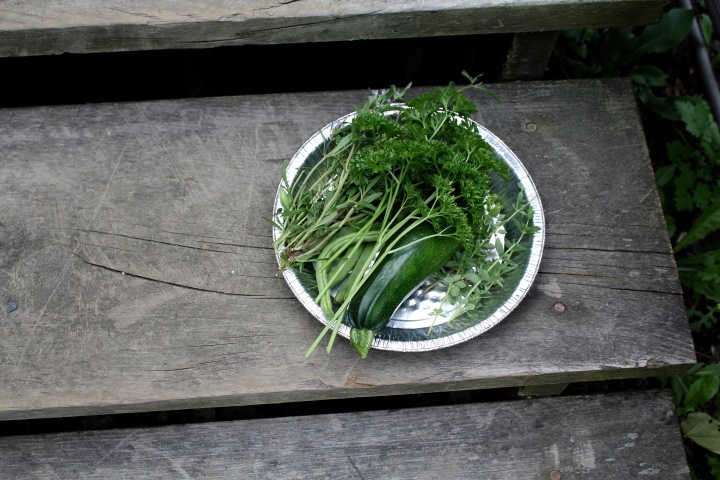
Slipping through a gap in the make shift fence, Jackson’s neighbour, Kent, shows me his patch. He has a much larger plot and is an experienced gardener. There is a lovely mix of herbs and annuals as well as vegetables both winter hardy and tender. On one of the steps leading into Kent’s house, sits a foil plate with the makings of tonight’s dinner: a perfect courgette, some green beans and herbs.
Jackson preserves some of his produce but mostly it’s eaten fresh. His space is not big enough for large volumes of produce but he has is eye on a patch of ground that does not belong to any of his neighbours which could, potential, become a community garden. Again, he will have to have a discussion with the authorities before this can become a reality.
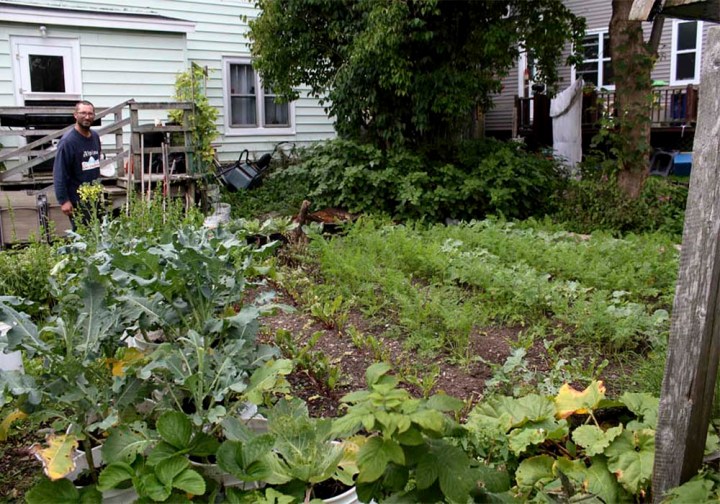
While signing my life away at the car rental office, car hire man Sam tells me with a big, Canadian, white toothed smile, that he has managed to upgrade me and I think, oh no! Therefore it is the big, black, tank of a car that I climb in to and it takes me about 20 minutes to figure out all the buttons and blinkers before I can, with slightly sweaty hands, throw myself into the traffic.
I drive to St. Phillip’s Cove to have a look at Conception Bay. There a shed is nestled between the water’s edge and the road, where I meet and introduce myself to Max. Max is retired but not sitting still. He builds boats for himself and his family, he does it because he loves the sea and he needs to keep his hands in business.

Behind the shed he has salted fish drying, much in the way that it was done in the late 1700’s. The flies swarm over the salted fish, ‘great day for drying’ says Max as he pulls out a small fish for me to smell.
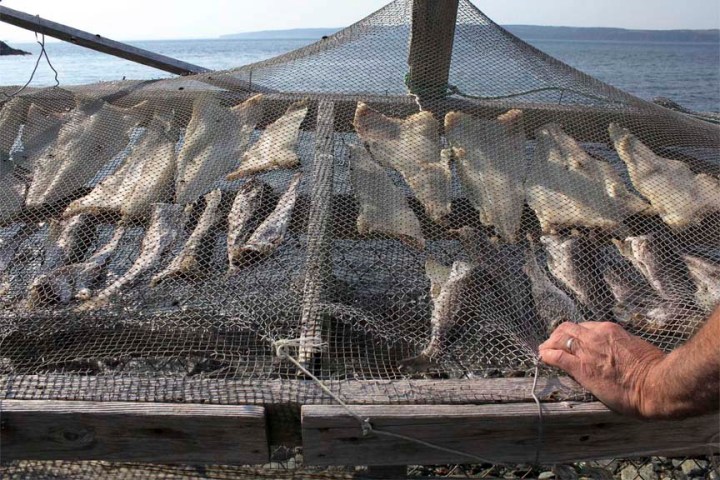
I am up early as I have an appointment in Heart’s Content to meet a man to talk about the Transatlantic Cable which was laid in 1857. The other end is in Valentia, County Kerry. Although this is not strictly about food, it does give me the opportunity to get out of the city and see what the land holds in terms of food production and availability and just the look of the land itself.
It is an amazingly sunny day; people are out washing their cars in their shorts and the sea is so blue it is hard to look at.
In the Tank I find myself flying out of St. John’s and straight away the countryside starts. There are forests for as far as the eye can see and this continues as I end up on the Trans Canada Highway.
In Heart’s Content I meet some fishermen gutting fish on the small pier. We have a great ‘chat’ about the town and they promptly decided that they would give me some fish, fresh as can be. Fish here = cod, unless specifically stated as to being something else.
They tell me that there is so much fish, the quotas are holding them back and yet they understand the reasoning behind it.
After the drastic but necessary immediate halt of cod fishing by the government, it has taken 25 years for the embargo to have a positive effect. The fish stocks have recovered, maybe not to the original bountiful quantities, but enough to allow a strictly controlled amount of fishing to resume. The collapse of the fishing industry was catastrophic for places such as Newfoundland. The lives of over 30,000 firshermen, not counting the extended employment it brought, were changed overnight. People who, for their whole lives had fished, who regarded their identity as fishermen, were suddenly thrown into a life where they did not know what to do with themselves. The financial, physical and mental implications on such a vast number of people was devastating. The fishermen had warned about the stock collapse but they were not listened too and in the end, it was they and their families that ended up paying the highest price.
At Boar’s Point there is a small harbour where some 10 boats of all sizes are tied up. I look into the very clear water and it is teaming with pike. The boats are named for love ones and many have returned from this morning’s fishing, making use of the fine weather as winter starts early here.
Paul is one of these fishermen and his boat was built by his two sons, daughter and himself. His whole family is employed in the industry; the wife works in the factory nearby and his children have various fishing related jobs.
We talk of the beauty of this place and the pace of life. Paul’s parents fished and farmed, selling locally and he has his own small vegetable garden by his house. The possibility of eating only food that is produced caught or foraged from the hills behind, if only ‘we were not so spoilt’, is something that he would like to encourage.
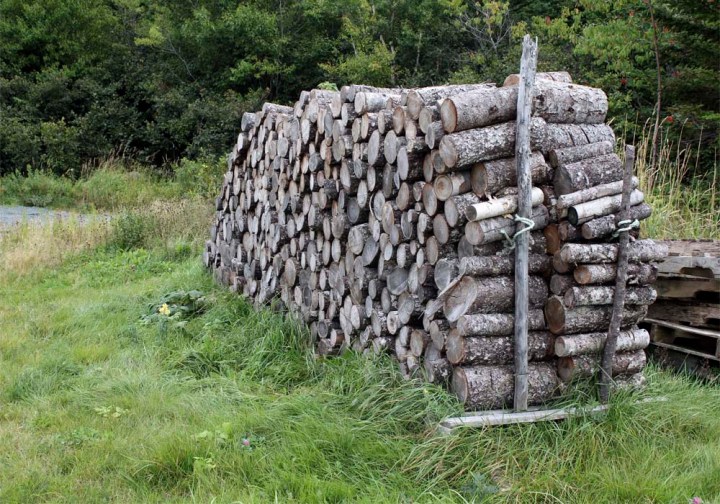
Paul sells half of his catch, whatever it may be, locally and the rest is sold to the processing plant nearby. The processing plant to which he is attached, has been buying his catch for many years. Each year the price is renegotiated but he feels that he is getting a fair deal. As I prepare to go he quietly says: ‘we could be self sufficient you know, dairy might be hard, but we could, we choose not to, I wonder how this is going to end’.
It’s Sunday and we are we are off to meet some friends at the ‘Squid Jigger’ in Calvert for lunch. It’s on the Irish Loop so we think we know what to expect. The Irish names are everywhere and of course all the tourist trappings too. Occasional big vistas open up to a view but for the most part the road meanders along the dense, spruce forest.
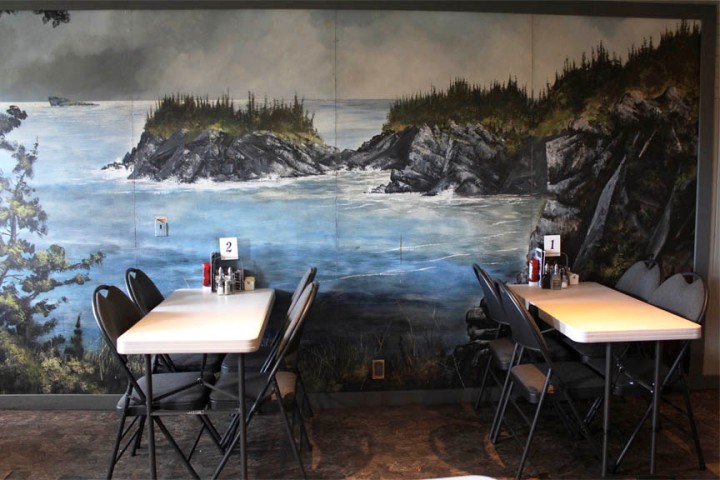
Lunch is great, fish so fresh it probably just came off the boat straight onto our plates. The conversation runs between our lunch group and it’s great to be among people who come from here. There is the easy familiar banter among the clientele and the waiting staff and the décor is fantastic. There is a large mural by the local artist Gerald L Squires. The tables and chairs are practical, simple and serviceable and remind me of a parochial hall or a sit down dinner dance some years ago in Ireland. This place, like many I have now been in, reflects such functionality, either this is a reflection of it’s past or maybe it is just the way it is.
After lunch we go and do a very Canadian pastime: picking blueberries and they are everywhere. On foot, we dive into a well-worn path among the trees that used to be a childhood get away of our local leader. We also taste the leaves of spearmint and are shown Labrador tea. Not that I can take any home because if you boil it, it becomes poisonous. Local knowledge, a valuable thing and I hope it will not all be lost before it can be passed on.
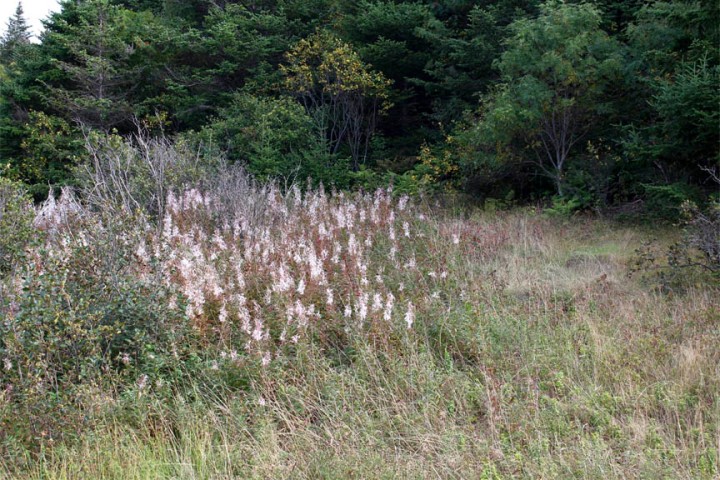
Of all the food that could be foraged, blueberries is the most common and done by many. You see people coming out of the thick forest paths holding containers (which I now know are full of berries), while driving along anywhere. You can find the blueberry included in so many things. I have drunk blueberry tea, had blueberry loaf, smoothies, pancakes, the list goes on. There is also a dish called ‘Buckle’, I think it’s a bit like cobbler, by listing to the cooking instructions, it is served with, guess what, blueberry ice cream. They are all made from local berries and yet in the supermarket they sell blueberries that come from the U.S. I suppose it is because some people just prefer to buy the generously packaged, ready to go, washed and sanitised, hassle free berries off the shelf. They are not cheap though, so maybe the money does not matter to some.

It’s a wonderful afternoon and wonderful too to see a place where a family grew up and even though their Irish roots are deep, they are so firmly Newfoundlanders. Driving back the sun is setting and all the changing colours of the incoming autumn are reflected in the still, calm water of the ‘ponds’ (nothing is called a lake here, must have something to do with the scale of the province), encircled by the deep green firs, ochers and orange from the sprinkling of Rowan, Sycamore and Beech.
Todd Boland of the Memorial University of Newfoundland (MUN) Botanical Gardens and I have an appointment at the Gardens to talk about heritage plants that still exist here. I was curious if there was still a direct line, through plants, to the immigrants who populated this island.
This is a large, beautiful site. Included is a park in which 14 acres have been left to their own devices and which, in turn, has become a haven for Osprey.
Here is a place of learning, not just for the academia but also for the general public. There are workshops on vegetable gardening, seed collection, compost, children’s gnome hunts, bird watching and much, much more. Set high up on a hill, where else, the plants that I recognise often have small differences to the plants in Ireland. The names are different too; our Rowan is called Dog Berry here.
Just outside the activity building, there are some raised beds made up to encourage the growing of vegetables or, a bed, which shows how you can intersperse vegetables with flowers. A honking great trio of red cabbages looks wonderful among the Cosmos and the annual Sweet William, all still in full bloom. I watch as some visitors look at this bed and I am not sure if it is wonder, appreciation or confusion. People like their green lawns here, spending great amounts of money on product to keep it looking good. It’s a very tidy city, in that way. All the lawns and flowers beds are prim.
Todd himself grew up with vegetable and flowerbeds. The vegetables in the veg plot here at the garden offer all the usual root vegetables and potatoes but there is also an attempt to introduce broad beans, leeks and other hardy plants that could survive the short growing season and provide food.

Todd is also very keen that commercial garden centers supply stock that has been proven to be viable, rather than selling plants, which end up being a disappointed to the armature gardener. Take for example the apple tree. Mayor investigation and research has gone into producing a tree that is free from scab, which is such a problem here, but these are hard to find for sale in nurseries. It makes no sense to him, or me.
Todd has a weekly gardening slot on the radio (CBC 88.5, should you be interested) where he answers listener’s questions. I heard it, per chance, after our meeting and the questions asked by the phone-ins were the same as what we had just discussed; growing food and making soil.
Compost and the making of soil is a big thing here. This place is not known as ‘The Rock’ for nothing. The Botanical Garden has been very creative about this. Negotiating with the larger city parks they now collect four or five lorry loads of leaves each autumn. The leaves, with a three-year rotation, become valuable ‘Black Gold’ for the garden. The university, to which this Garden is attached, now saves all the compostable leftovers from the kitchens too. By adding this free matter to their own compost heap they no longer need to buy any mulch or fertilizer.
The Heritage bed was started about 20 years ago when the Garden put a call out for plants that were still in existence from ‘homelands’. The marker was put at the post 1940’s and the donations came flooding in. What amazes me is that immigrating people took the trouble to bring plants with them on their journey, not seeds. There must have been great sentiment attached to these tubers and roots to decide to pack them along with all the essentials that were to be brought to a new land.
A plant of interest is Sedum. It is very popular here as it can withstand the climate and it has a long flowing season. One of the most common places for it to be found is in graveyards. Monkshood was also brought with by immigrants and one would wonder why as it is a poisonous plant. And then there is one I particularly like, though I have never come across it before. It’s called ‘Boy’s Love’ and when you rub the leaves it smells of a cola drink. Apparently it is a moth repellant.
Todd is a wonderful, progressive man, keen to give as much information as he can and his brain is like an encyclopedia of all things flora and fauna, but emphasising the flora. He is full of optimism for the future about the food situation here but he feels that it is going to take a long, long time before there is either an adjustment of taste or an acceptance of planting ‘that drill of potatoes in your front garden, instead of that perfect grass’.
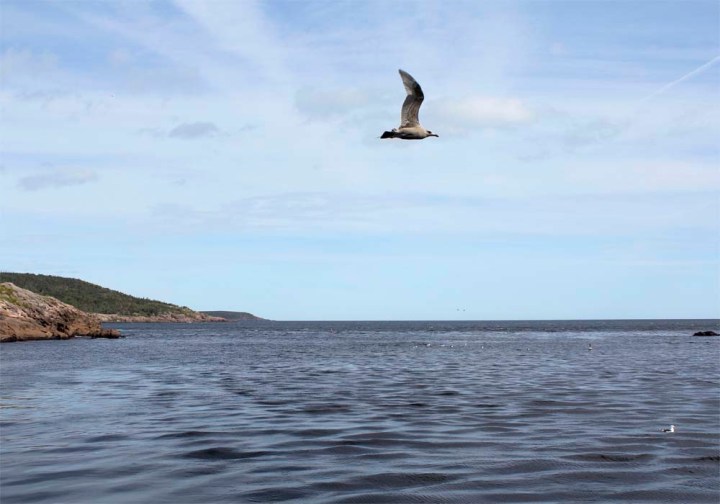
Leaving the Botanical Gardens I head off to Portugal Cove to check out Murray’s Organic Farm. Murray’s is one of the larger organic farms in this region. The blue-shingled building with red tar shingled roof, sitting on a hill overlooking big landscape facing the sea and offers a very welcoming atmosphere, the staff are happy to be here too. Evin, the son of the man who started all this, has recently taken over and there has been a bit of development. You can now buy other local producers produce here, no vegetables of course, and get a cup of gourmet coffee in the café and some healthy food to go with that.
This place is well organised with a rotation of crops and the experimenting with new products. This ‘modernisation’ was developed to see if the general public would appreciate it. The hardest for Evin to get is a supply of an affordable workforce and he makes full use of Woffers who come rambling by.
Murry’s sell half of their crop to the ‘enlightened’ restaurants, and much of the remainder at the farmers market in St. John’s. Locals also drop in and head straight for the cabbage, the root vegetables and perhaps, more progressive crops such as celery and fennel.
This whole farm is about 10 acres in size and a half an acre of that is under plastic. The pollytunnels, covered in durable plastic, are warmed with an external, generator led heating systems, especially important now that the weather is starting to turn a little colder. Recent new workshops in gardening and foraging are constantly booked up and seem to be going down well.
This area of Portugal Cove is also home to Robinovitz’s, a smaller organic smallholding, picturesquely placed on a hillside overlooking a valley. They open to the public on a Saturday and they also do a ‘green bag’ once a week, which is delivered to a drop off point in St. John’s. I arrive unannounced but Mike, the owner, does not have a problem with that and gives me free rein to wander where I wish. I like this place, it feels like a friendly, family run veg plot, with strong organic beliefs.
This morning is a beautiful day as I drive to Foxtrap, a place that looks much like some other places I have visited. A wide road running through the town and on to other destinations is intercepted with many side roads that carry names like Fagan’s Road, Butler’s Lane, Traffic Lane. It sometimes feels like they are running out of names, but then there are so many roads. People live in detached, mostly bungalow style housing. Away from St. John’s there are less bright colours and each house, of course, is surrounded by a front garden and a patch of well maintained grass. There are more fruit trees around and on the side patches by the houses, a bit of food growing. There are stalls along the roadside selling produce and small glasshouses (made of stiff plastic) nestle in odd locations.
My reason for being here is to meet Frank. I met Frank at the Farmers Market last Saturday and struck up a conversation about his blue potatoes known here as Newfoundland long blues. As we discuss heritage potatoes and I tell him about the varieties I grow at home, he invites me out to see his patch. Frank grows organically, he does not see why not.
It takes me a while to find Frank’s house, as I cannot image that a supplier of food to restaurants and a market, can live so suburban. Eventually I stop and ask and I am pointed to a house that sits right beside the water. The view is fantastic. Frank used to work as a soil expert and is now retired. He and his wife garden their half-acre plot and again it shows just how much food you can grow in a small space.
Frank maintains that by growing beside the water, the season is actually extended and the salt does not affect the crop. It seems to be working for him. Frank’s former job, focused on research and experimentation and he uses this knowledge in coming up with interesting solutions to potential garden problems so that he can produce a crop that is tasty and environmentally friendly. Frank leans down to grab a handful of soil, it is rich and loamy and it smells great.
Frank collects seeds from some of the lettuces he grows but for all the others crops he prefers to start with fresh. He has a restaurant client to satisfy and he also knows he cannot forecast the weather, but at least with the seed he feels he has a fighting chance of being able to grow a crop. Frank grows food because he believes in the value of it, he also believes that providing a crop that is local, he is, in some small way, helping to lessen the food importation dependency, one that could so easily become a crisis in this province.
I had spotted the little harbour nearby on my way into Foxtrap so I park up, close to the water. Just to sit there, looking at the sea; the edge of land, enjoying the sun when suddenly I become aware that I am also looking at a large crop of pumpkins. A passerby tells me that ‘Mike and his new wife own the patch’. The half-acre or so is overflowing with pumpkins of all sizes and stages of ripeness. As well as that, there are goats in a holding pen conversing with anyone who walks past. I wander over to pay my respects and meet the man himself.
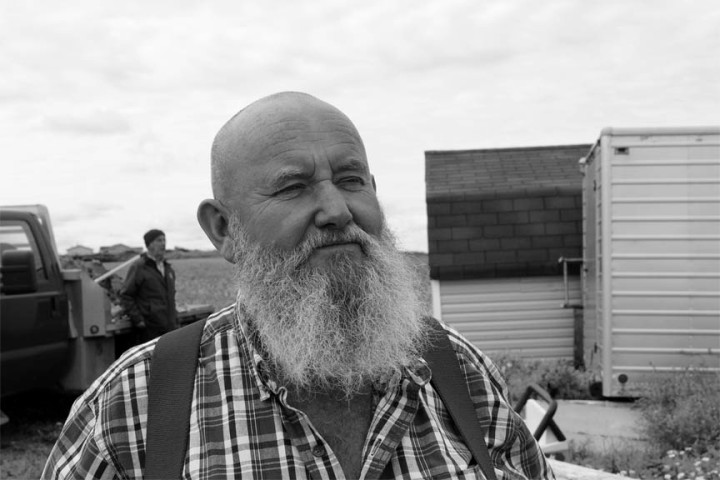
Mike has been growing food here for years. First the greens in the springtime and followed by the pumpkins. The soil looks stony and dense but it obviously does fine for him. Each year there are school trips to this field so that children can find their perfect Halloween pumpkin. . “Newfoundlanders don’t really eat much pumpkin”, Mike tells me; pity really as this crop grows so well here.
Invigorated by the conversations and the beautiful weather, I set off for Petty Harbour (I wonder if the name comes from the French ‘petite’).
This cove, gently embraced by the tree-covered hills, is very much a small boat working space. Tourists come and take their snaps, but it is really a harbour with a fish factory on one side and independent fish huts, on stilts, on the other side. There is work going on in the small huts. Through a hole in the floor the cast off fish remains plunge into the black looking water and the gulls are waiting in groups to devour the free, no effort food. All the information signs are in English and French here, with the English coming first.
I wander to the end of the Catholic side of this harbour (yes, there is a Protestant side too) and a local is happy to tell me that this side gets more sun. A boat is leaving the calm harbour water into the big wide Atlantic Ocean. Today is a warm and sunny day, but I can image this place in more difficult weather where you go from safety into a sea that looks so big, with the horizon, indeed, looking like an edge.

It is late in the evening and I am in the airport departure area. Sounds big, but it is not.
I sit back and ponder just what it is that I have learned about food, food production and if there is any tangible connection left between Ireland and Newfoundland on this topic. I have spoken to many people about food from all different angles and I realise that there is a heritage through plants and meals, but food production is a none nationality, profit-making enterprise.

This is a wonderful part of the world where people are open and life is often lived with rawness. Yet I ask myself again, ‘is there a link between Newfoundland and Ireland through farming and the practice?’ I am not sure that there is. There are those that grow food and those that shop for it. There are backyard farmers and the opportunities to visit an organic farm or one can go to Costco and buy more that can be consumed. I have met people who feed the hungry and others who like to forage to live more off the land as the initial immigrants in the 1800’s did, but what really has this to do with Ireland.
People grow root vegetables because they can. The plants can handle the short growing season, they do well, store well over winter, but it is not specific to Ireland.
I think what I have discovered is that when you mention that you live in Ireland, people converse with you in a different way. There is an element of instant trust and understanding. Of course people came from many countries, England, Wales, France, Portugal etc but the most came here from Ireland. And it is this link, an understood tradition (think Coddle and Jiggs dinner, the music and the chat), that is what makes the connection. Food is certainly what I ended up talking about in the main conversation, but it always started with a little grounding, finding out where each came from in Ireland or what connection there could be. It was always with a smile that came as soon as I mentioned that I live in Ireland.

































